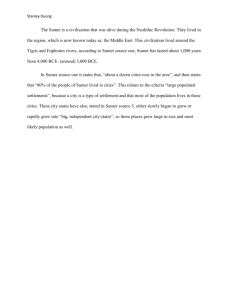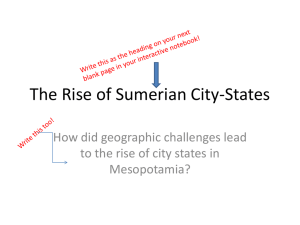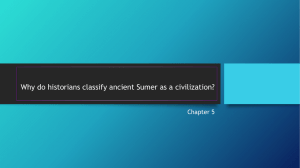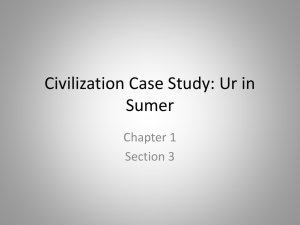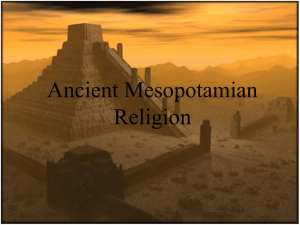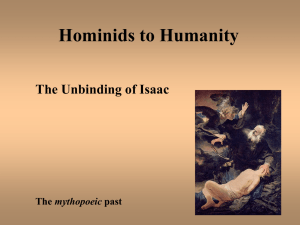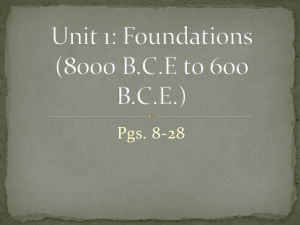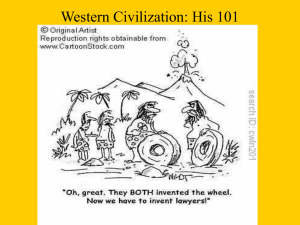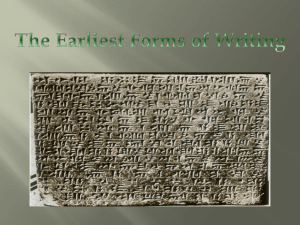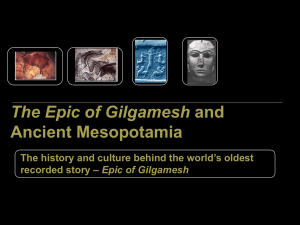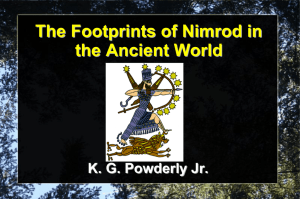File
advertisement
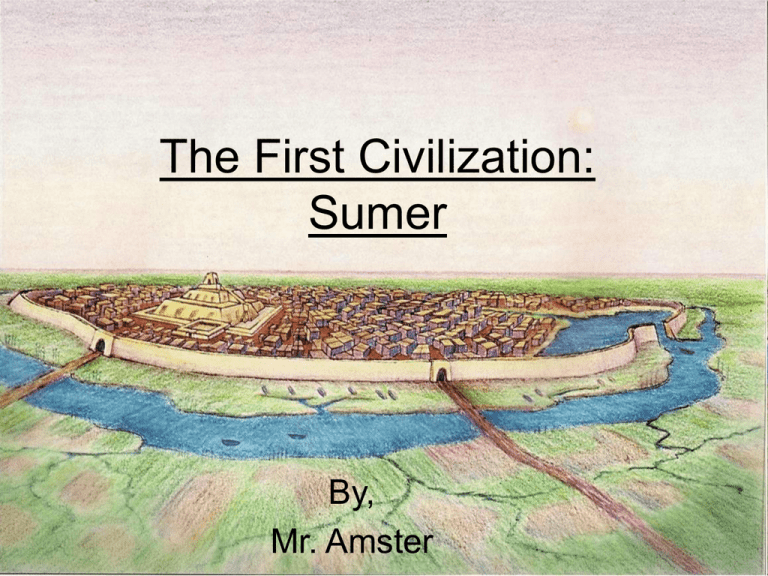
The First Civilization: Sumer By, Mr. Amster Silent Do Now • What are the 7 characteristics of a civilization? Agenda • • • • Do Now Agenda Homework Geography Notes and Worksheet Homework • No homework Key Vocabulary • Mesopotamia – Land between two rivers (Tigris and Euphrates). • Fertile Crescent – Area of rich soil in Mesopotamia surrounded by dry areas • City-state – Early city that was similar to a small, independent country. It had its owns laws and government. • Arid – Dry area that lacks water. • Silt – Thick bed of mud. Excellent for growing crops. • Irrigation – Method of bringing water to a field from another place to water crops. • Levee – A wall of earth built to prevent a river from flooding its banks. • Cuneiform – Sumerian written language, made up of wedge-shaped markings. First KNOWN written language. • Scribes – A record keeper or writer. • Chariot – Two-wheeled vehicle pulled by a horse. • Ziggurat – An ancient Mesopotamian temple tower. • Arch – An upside-down U- or V-shaped structure that supports weight (doorway). • Polytheism – The belief in multiple gods. Mesopotamia Geographic Introduction • Located mostly in present-day Iraq, but also Iran, and Turkey. • Area is a river valley, located between two major rivers, the Tigris and Euphrates. It was ideal for the growth of civilizations. – River valleys are where the first civilizations arose all over the world • They had good farming conditions • The rivers provided fresh water, fish and an easy way to travel and trade. (Why are these important?). • Known as the Fertile Crescent because despite the region surrounding it being very arid, this crescent-shaped area has rich soil. – HOW? Every year the valleys are flooded by rain and snow from the mountains (Example is the Zagros Mountains). – Leaves behind silt. Mapping Activity • You will receive a worksheet with a blank map and a list of locations you need to fill in. Make sure to take your time and fill in your answers neatly. • You will be using the Journey Across Time textbooks. You will be using pages 17 and R19. – R19 – refers to the Reference Atlas at the front of the textbook. Do Now • Define: – Cuneiform – Mesopotamia – Ziggurat – Polytheism – Scribes Agenda • • • • • Do Now Agenda Homework Class Notes Activity Homework • Problem Solving Essay! • Due Wednesday Rough Times in Sumer • Mesopotamia is not an easy place to live. • There is little rain, soil is hard and dry, rivers only floods once a year, lack of building materials on the plains, and stone was scarce, and few natural barriers from invasion. • Key problems facing Mesopotamians: • Food shortage in the hills • Uncontrolled water supply • Attacks from neighboring communities • Difficulties in building and maintaining irrigation systems to help multiple villages • They need to find solutions to each of their problems, if they wanted to survive Food Shortage and Water Problems • People originally lived in Zagros Mountains. • The hills there provided rain, good place to farm, but there was a problem! • Around 5000 BCE, there was not enough land for farming to support the growing population. THE SOLUTION: people moved to south to the plains between two rivers. Although dry most of the time, every year brought floods for the farm. • The new region became known as Sumer! NEW PROBLEM!!! • The flooding was uncontrollable and its timing was never known. The rest of the year, the soil was dry. THE SOLUTION: people built levees or dams to control the water. • This allowed the people to water their thirsty fields year round. Dam Problems and Unfriendly Neighbors The Problem! • How to maintain irrigation across village boundaries? • The system had to be constantly maintained. One clog brought the whole system down. The Solution! • Farmers no longer lived far apart, they need to work together for the common good. • Each village had workers in charge of maintaining the irrigation. • Towns are beginning to form. New Problem! • Sumerians battled over access to the water. Cities upstream built dams and levees that prevented other cities from getting enough water. Invasions occurred not for land, but for control of water! The Solution! • City-states were created by the building of walls around the main parts of their city. They also created moats to limit the access points into to the city. During an attack, farmers would leave their farms for the protection of the city. By 3000 BCE, most Sumerians lived in city-states. Activity/Homework • After learning about Sumer and its ways for solving problems, it is your turn. • You will write an one page essay about a problem you have faced and how you solved it through teamwork and solid problem solving skills. • You may also create a problem scenario and solve it through teamwork and solid problem solving skills. • What is a timeline? • • SILENT DO NOW!!! Timeline A way of displaying a list of events in chronological order. It can show steps of development of an event. Sumer’s Timeline (remember to indent the bullets a little bit) – Pre – 5000 BCE: Neolithic people live in rolling hills of the Zagros Mountains. Good area for farming. – 5000 BCE: Zagros Mountain area not able to support population, people moved to the south to the plains around Mesopotamia. – 3500 BCE – Wheel invented – 3500 – 3000 BCE: Growth of city-state like Ur and Uruk. – 3200 BCE: Pictographic used for record-keeping. – 3000 BCE: Pictographic signs write the Sumerian language – 2500 BCE: First written account of war. – 2400 BCE: Signs become cuneiform – 2300 BCE: Sumerian cities are united by Sargon – 1900 BCE: Akkadian becomes the main language of Mesopotamia – 1800 BCE: Hammurabi unites all of Sumerian cities with the capital of Babylon. FYI 1800s CE, Sumerian cities start being excavated. 1900s CE, Sumerian language translated Agenda • • • • • Do Now Agenda Homework Timeline of Sumer Timeline Activity Homework • Create a timeline of the key events in Sumer – Each event must have a picture that shows the event. – Due Tomorrow Additional Do Now • Identify two geographic features that allowed for Sumer and the rest of Mesopotamia to be successful. • When a big problem is in front of you, what is the first thing you should do? Creating a Visual • Now it is time to create your own timeline. • Use a ruler to create a line across the page. Keeping it to scale, insert important dates, the event it corresponds to, and a picture that represents it. Do Now • Share your timelines with your partners • Be prepared to go through to confirm answers. Agenda • • • • • Do Now Agenda Homework Create your own notes Share notes Homework • Is Sumer a civilization? How so? – Write a paragraph that sites three examples for the days notes that support your answer – Due Tuesday Questions for Each Characteristic • Does Sumer have this characteristic? • If so, what are examples of the characteristic? • What did having (or lacking) this characteristic do to the development of Sumer? Sumer’s Culture Sumer’s Food Supply 1. Yes, they had a stable food supply. 2. 3. 1. 2. Yes, they had an advanced culture. Examples: They invented irrigation 1. systems and the plow. 2. 3. 4. 5. It gave them ability to survive and focus on other activity. This gave them ability to continue to develop. 3. Metal workers – weapons, cups, mirrors, and jewelry. Musicians – lyre, drums, pipes. Artists – paintings. Craftsman Architect – designed temples/Ziggurats. These pieces of culture showed Sumerians values, their views on entertainment, expressing their feelings, and desire to bring to joy to daily life. Sumer’s Religion 1. Sumerians’ were polytheistic. 2. Performed numerous rituals including weddings, sacrifices. Gods were apart of their daily lives. 3. Religion was apart of their daily lives. People believed that if the Gods are happy, good things will happen. Sumer’s Social Structure 1. Sumer had a well developed social structure. 2. Pyramid 3. 1. Ensi 2. Upper Class 3. Common Class 4. Slaves Designated jobs to different classes. Sumer’s Technology 1. Sumer had advances in Sumer’s Writing 1. known written language. technology. 2. They had the arch, 2. Sumer used cuneiform or wedge-shaped markings. wheel, and were the Sumerians originally had first to divide the hour 3. Sumerians had the first over 2000 symbols, but into 60 minutes. were able to shorten it to These inventions gave 700 later on. them ability to move heavier objects. 3. This allowed Sumerians to keep records. Writing allowed for humans to develop quicker by learning from the past. Sumer’s Government 1. 2. 3. Sumerians had government. Ensis were in charge of the government. They were responsible war, creating/enforcing laws. The order the government brought, allowed Sumerians to focus on their work. They knew what they were allowed to do and not do. Do Now • What is a division of labor? • Grab your essay from the bin and read your essay to your partner. Then… • Be prepared to discuss the analysis sentence. – UNDER LINE THAT SENTENCE NOW! Agenda • • • • • Do Now Agenda Homework Sumerian Literature Notes Epic of Gilgamesh Homework • Finish answering the questions about the Epic of Gilgamesh. • Due Tomorrow • 50 point MC quiz and binder check Thursday! – Use your notes on Sumer as the study guide!!! Sumerian Literature • Before writing, stories were passed down by oral traditions or information that is passed down from one generation to another through word of mouth. • The Sumerians created several works of literature, none older or more infamous than the Epic of Gilgamesh. • It is a story that focuses on King Gilgamesh, who travels around the world with a friend and performs great deeds. After the death of his friend, he searches for a way to live forever. Do Now (Add to 52) What are these ancient locations? F E D C H G I B A Agenda • • • • • Do Now Agenda Homework Mesopotamian Education Compare and Contrast Homework • Create a Venn diagram that compares Mesopotamian education to education today. • Then answer the question, “In what way is education different today than it was in Mesopotamia. • Due Tomorrow • 50 point MC quiz and binder check Thursday!!! – Use your notes on Sumer as the study guide!!!
